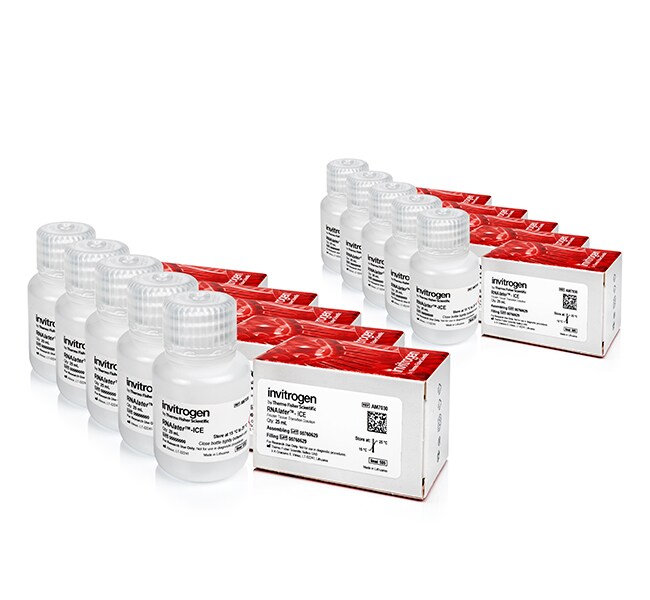Search

RNAlater™-ICE Frozen Tissue Transition Solution
| Número do catálogo | Quantity |
|---|---|
| 4427575 | 10 x 25 mL |
| AM7030 | 25 mL |
RNAlater-ICE is a novel reagent for transitioning frozen tissue to a state that is easily processed for extraction of high quality RNA. Frozen tissues are simply submerged in RNAlater-ICE and allowed to thaw overnight at -20°C. Once thawed, the tissues can be processed like fresh tissues using standard RNA isolation procedures. No more laborious grinding of frozen tissue to safeguard the RNA.
• Process previously frozen tissues like freshly harvested samples
• Thawing tissues in RNAlater-ICE protects RNA from degradation
• No more tissue pulverizing with mortar and pestle and awkward transfer of powder to tube
• Easily apportion frozen tissue samples for multiple experiments
• Quick Freezing Tissues Preserves RNA
Often, tissues that need to be stored prior to RNA isolation are “snap” or “flash” frozen on dry ice or in liquid nitrogen to preserve RNA integrity. RNA in tissue is stable while frozen at -80°C but thawing the tissue prior to or during its disruption can result in RNA degradation. This is true even if the tissue thaws while in the denaturation solution.
Processing Frozen Tissues is Problematic
Frozen tissues are typically ground with a chilled mortar and pestle in order to maintain RNA quality. Liquid nitrogen must be added to the mortar to keep the sample frozen while it is ground. For multiple samples this process is laborious. Either a separate mortar and pestle set is needed for each sample, or the set must be thawed and cleaned after each sample is processed to avoid cross-contamination. Powdered tissue can also thaw during transfer to a homogenization vessel. This often results in formation of clumps that do not readily disperse in the lysis solution, resulting in RNA degradation and loss. Very small samples should be homogenized immediately in lysis solution, which can again be cumbersome if there are multiple samples to process.
Process Frozen Tissue Without Jeopardizing RNA Integrity
RNAlater-ICE solves all of these problems. Simply submerge frozen tissue samples in 10 volumes of RNAlater-ICE and store overnight at -20°C (the solution will remain liquid at these temperatures). As the tissue thaws, RNA integrity is protected. Once treated, tissue can be safely stored at 4°C or even at room temperature (for a limited period of time) and can be further dissected or processed prior to homogenization in a standard RNA isolation lysis buffer. Thus the same frozen tissue sample can be used multiple times for different experiments without compromising RNA integrity.